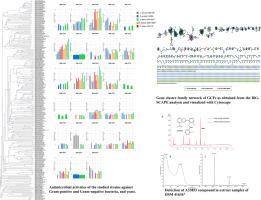来自全球不同环境的 28 株新型放线菌的生物技术和制药潜力
IF 4.8
Q1 MICROBIOLOGY
引用次数: 0
摘要
放线菌是生物活性天然化合物的丰富来源,其中许多可用作抗生素或其他药物。在这项研究中,我们调查了几十年前存放在德国微生物和细胞培养物保藏中心(DSMZ-German Collection of Microorganisms and Cell Cultures)的 32 株放线菌的基因组和生化多样性。基于基因组的系统发育和 DNA-DNA 杂交支持将这些菌株归入 26 个新种和 2 个新亚种,并对一个链霉菌种进行了重新分类。这些结果与菌株的生化、酶学和化学分类学特征一致。大多数菌株对一系列革兰氏阳性菌、革兰氏阴性菌和酵母菌具有抗菌活性。基因组分析表明,菌株中存在许多独特的生物合成基因簇(BGC),这些基因簇可编码潜在的新型抗生素和抗癌化合物。菌株 DSM 41636T 和 DSM 61640T 分别产生了抗生素化合物 A33853 和 SF2768。总体而言,这反映了拟议的新型菌株在制药和生物技术方面的巨大潜力,并强调了原核生物系统学在药物发现方面的作用。为了弥补原核生物物种命名中的性别差距,我们建议将所有新描述物种的外来名称命名为女性科学家。本文章由计算机程序翻译,如有差异,请以英文原文为准。

Biotechnological and pharmaceutical potential of twenty-eight novel type strains of Actinomycetes from different environments worldwide
Actinomycetes are a prolific source of bioactive natural compounds many of which are used as antibiotics or other drugs. In this study we investigated the genomic and biochemical diversity of 32 actinobacterial strains that had been deposited at the DSMZ–German Collection of Microorganisms and Cell Cultures decades ago. Genome-based phylogeny and in silico DNA-DNA hybridization supported the assignment of these strains to 26 novel species and two novel subspecies and a reclassification of a Streptomyces species. These results were consistent with the biochemical, enzymatic, and chemotaxonomic features of the strains. Most of the strains showed antimicrobial activities against a range of Gram-positive and Gram-negative bacteria, and against yeast. Genomic analysis revealed the presence of numerous unique biosynthetic gene clusters (BGCs) encoding for potential novel antibiotic and anti-cancer compounds. Strains DSM 41636T and DSM 61640T produced the antibiotic compounds A33853 and SF2768, respectively. Overall, this reflects the significant pharmaceutical and biotechnological potential of the proposed novel type strains and underlines the role of prokaryotic systematics for drug discovery. In order to compensate for the gender gap in naming prokaryotic species, we propose the eponyms for all newly described species to honour female scientists.
求助全文
通过发布文献求助,成功后即可免费获取论文全文。
去求助
来源期刊

Current Research in Microbial Sciences
Immunology and Microbiology-Immunology and Microbiology (miscellaneous)
CiteScore
7.90
自引率
0.00%
发文量
81
审稿时长
66 days
 求助内容:
求助内容: 应助结果提醒方式:
应助结果提醒方式:


